Uncategorized

Posted on
January 23, 2023
1 Min. Read
Author
Purple Strategies
Purple Joins George Mason Coach Kim English in Coaches vs. Cancer ‘Suits and Sneakers’ Week
Purple co-founder and CEO Steve McMahon and Kim English, head coach of George Mason University men’s basketball, have teamed up for the American Cancer Society’s “Set the Screen” effort to encourage a return to recommended cancer screening.
“The fact that cancer screenings dropped by more than 90% during the pandemic was a sobering statistic for Kim [English] and me to learn,” Steve McMahon said. “Every one of us at Purple has a personal connection to cancer, as do Kim and his team and everyone in our community. We all know decreased and delayed cancer diagnoses and treatments will result in far too many negative outcomes for far too many people and families. I’m honored that Kim asked me and our Purple team to join him in this effort to encourage screenings, and we’re proud to be with him, George Mason, the American Cancer Society and all those on this mission to end cancer.”
Coaches vs. Cancer (CvC) is a nationwide movement created 30 years ago that unites coaches across the country, along with partner CEOs in their communities, to raise funds and awareness about the fight against cancer and promote the American Cancer Society as a source of inspiration and hope for those facing cancer. This year during CvC’s Suits and Sneakers® Week (Jan. 23-29), coaches, companies, CEOs and health providers are joining together for a Set the Screen campaign, designed to call attention to the critical importance of cancer screening.
For more information on cancer screenings, and to join coaches and their partner CEOs in the fight against cancer, visit coaches.cancer.org.
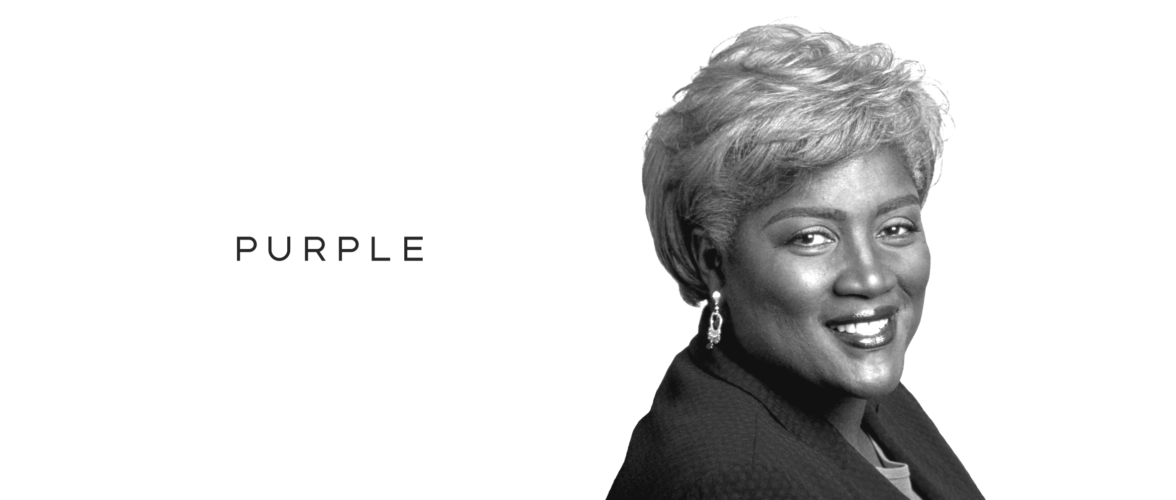
Posted on
December 7, 2022
2 Min. Read
Author
Purple Strategies
Donna Brazile Joins Purple
Purple Strategies welcomes veteran political strategist, New York Times bestselling author and Washington icon Donna Brazile as a senior advisor.
“CEOs are seeing the political and social issues of the day playing out not just in the society in which they operate but also among investors, activists, NGOs, and increasingly, within their own walls among their employees. And they are seeking help from those who have the sophistication, experience, and judgment to advise them in navigating this changing dynamic. Donna Brazile is exactly the kind of seasoned thought partner a smart executive wants to have in their corner,” said Steve McMahon, Purple co-founder and CEO. “The perspective and wise counsel Donna brings, and the reputation she has earned within both the Beltway and boardrooms, will be a meaningful addition to our Purple roster and to our clients.”
Donna is a veteran political strategist, New York Times bestselling author, chair of the J. William Fulbright Foreign Scholarship Board, and sought-after Emmy- and Peabody-award-winning media contributor to such outlets as ABC News, USA Today and TheGrio. She previously served as interim Chair of the Democratic National Committee and of the DNC’s Voting Rights Institute. Donna was the first Black American to serve as the manager of a major-party presidential campaign, running the campaign of Vice President Al Gore in 2000. She serves as an adjunct professor in the Women and Gender Studies Department at Georgetown University and served as the King Endowed Chair in Public Policy at Howard University and as a fellow at the Institute of Politics at Harvard Kennedy School. She has lectured at nearly 250 colleges and universities on diversity, equity and inclusion; women in leadership; and restoring civility in American politics.
“Steve and I both consider ourselves lucky to count Donna as a longtime friend and we’re excited we can finally paint her Purple!” said Alex Castellanos, Purple co-founder and chairman. “Donna is one of the finest human beings I know. I have enjoyed time side by side at podiums and in television studios – at first by chance, then as pundits, and now intentionally because we choose to. Working together reminds us how much strength and clarity can come from approaching any topic or issue from different perspectives. That idea has been at the very heart of Purple since we began, and we’re proud to have Donna with us advancing that ‘Purple’ approach moving forward.”
“I couldn’t be happier about joining the team at Purple,” Donna Brazile said. “Alex and Steve are great friends from way back. Just as important, they are both consummate and dedicated professionals who have built something incredibly special with Purple. I very much look forward to spending time and making a difference with all of the great people at Purple.”
Donna is the second senior advisor Purple has added to the team this year. David Bickerton, seasoned communications, advocacy and corporate reputation leader and visiting fellow at the University of Oxford, joined the firm as a senior advisor earlier in 2022.

Posted on
October 13, 2022
4 Min. Read
Author
Roberta Hatchett
Diverse Perspectives in Issue Management Bring the Unseen to the Surface
A deeper audience understanding is needed to navigate crisis and corporate reputation
By Roberta Hatchett, Purple Senior Director
Independent feminine care company Honey Pot reached $6.4M in revenue in 2021 and holds Black American women as one of its primary audiences. Over the summer, Honey Pot worked through a labeling and communications issue that left it on the edge of irreparable brand damage. In short, the company changed preservative ingredients that called into question its organic certification status.
An ingredient reformulation coupled with a lack of communication is a serious matter for any hygiene company to navigate, and it would be easy to approach the problem as one of packaging and disclosure. However, a more consequential issue was below the surface – rooted in a deeper understanding of the audience – that executives can learn from.
What We See
What was deserving of attention and immediately understood by the Black community and those who understand this audience was the potential for a different type of fear and resentment unrelated to product labeling. This fear comes from the decades-long history of Black-owned personal care companies being acquired by larger corporations that disengage, if not ignore entirely, their long-time customer base. Because of that pattern, if a Black-owned company makes a major shift (intentional or unintentional), its core audience assumes that it’s sold the business and receives the message it’s sold out its customers by turning over the reins to majority-white corporations.
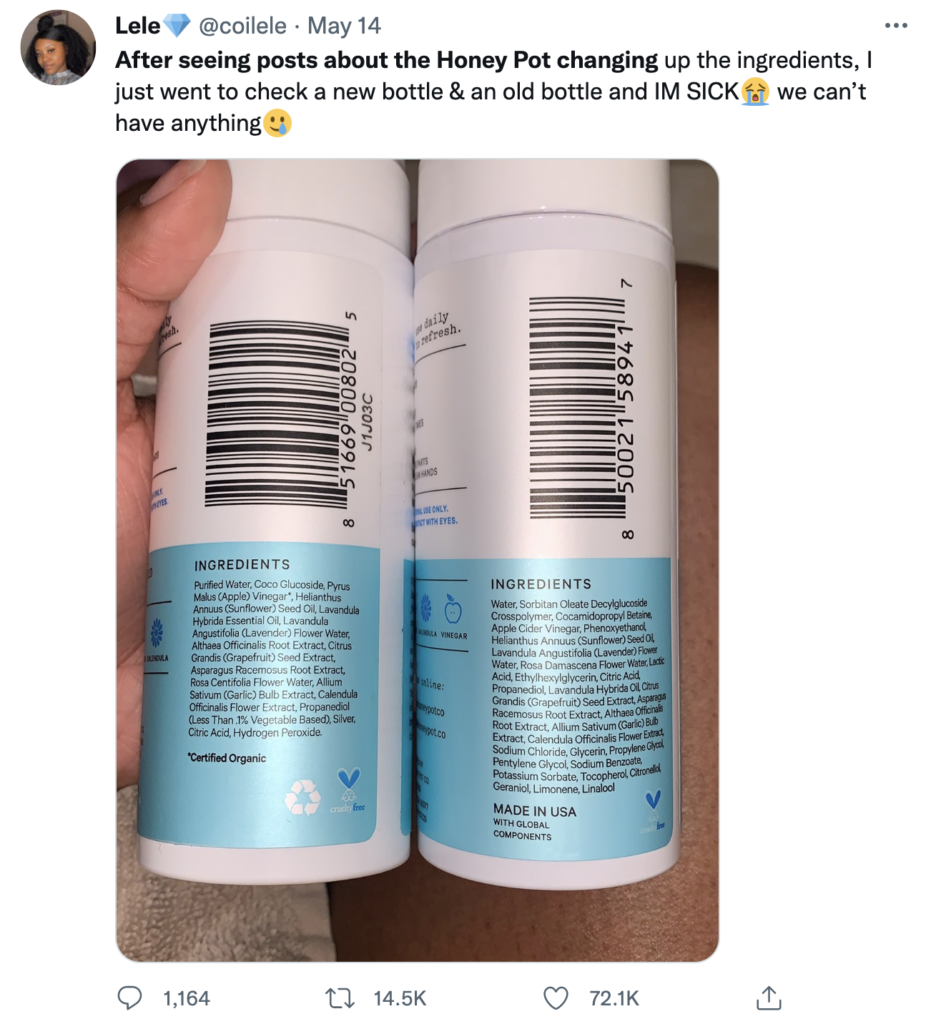

What It Means
Some communities recognize this issue immediately, though most don’t. Having a diverse set of perspectives assessing a challenge will make or break a company’s corporate reputation. Because, even with consumer data and insights in hand, if the right mix of people aren’t in the room, this is the kind of nuanced issue that can be missed. If Honey Pot had treated this issue as it appeared on the surface – as an ingredient issue – it would have failed to address a much deeper concern of its loyal customers.
CEO Beatrice Dixon held both concerns with equal regard when she addressed her social media audience in an impromptu statement within a day of the backlash. She validated the audience’s feelings and quickly confirmed that her company had not been sold.
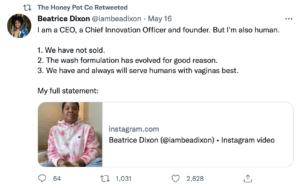
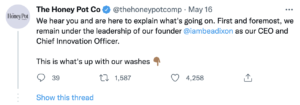
How We Got Here
Historically, most large corporations have neither understood nor done enough work to understand the needs of minority customers. In the delicate space of personal and hair care, many Black-owned businesses looked to the great Madam CJ Walker as the prototype. She filled a huge need and became wildly financially successful in the process. And although her company remained family-owned until it ceased operations in 1981, it was purchased by Sundial Brands in 2013. Shea Moisture – a beloved haircare brand with a large following among Black women – was sold to Unilever by way of Sundial Brands in 2017. Carol’s Daughter, another Black hair care line, had a valuation of $27 million at the time of its sale to L’Oreal in 2014. With each acquisition, the products and packaging changed, the marketing and communications changed, and the face of the company, i.e., the brand image, changed.

These acquisitions resulted in feelings of abandonment among the Black community and left consumers questioning whether wealthy, majority-owned corporations and priorities properly serve the Black community. What had been spaces to celebrate and nurture the unique personal care needs of the Black community were abandoned to serve the preferences of the masses.
Further, despite it being known that “representation matters,” acquiring brands seemed to translate that sentiment only into adding Black and Brown people in advertising. Consumers are savvy and see past these performative measures. They want to know their needs are considered at the production level and that their support (dollars) is benefiting their own communities. For Black consumers, specifically, this is a sentiment born out of a strong sense of community and loyalty – two values that are very important to minority groups. It’s a means of protection and preservation. And for the Black population in the United States, the economics of keeping money within the community psychologically translates to security and safety.
What Companies Can Do About It
The tendency with the acquisition of independent Black personal-care companies is that they become more “mainstream.” Products undergo changes to appeal to wider audiences. Companies also tend to deemphasize the needs of the original customers and instead use them as the basis to attract more mass customers. This leads that customer base to feel as if their patronage isn’t enough or is unimportant.
There are several actions corporations could take that – if authentic and not performative – could help to alleviate this consumer sentiment and position themselves as an extension and celebration of the community rather than an opportunity to change it.
(1) Audience insight. In the early stages of acquisition, companies would be wise to spend more time researching and understanding the existing customer base. Why are they the primary audience? What do they care about? What is their share of revenue contributed across the brands? How can we retain them as a customer?
(2) Communications and marketing strategy. When developing both internal and external communications, carefully consider how the new company is brought into the portfolio of brands. Is it given appropriate status and urgency, or is it shown a less-than-enthusiastic introduction? Even if the fanfare would be less than that of a larger company for financial reasons, be mindful that the perception may be that’s because it’s a minority-owned company. Externally, is the marketing of the new brand inclusive and done so in a way that instills trust? Is there open communication and opportunities for proactive growth? Customers are aware and generally distrustful of any change in a product they’ve grown to know and love. Taking care can go a long way in maintaining that relationship. In either case, authenticity and consistency is paramount.
(3) Product and brand planning. Long-term, how is the brand being managed? Are there resources in place to track how the brand is received by previous and newer audiences? During product development post-merger, how is the company ensuring the product will be the same, if not better, after acquiring the smaller BIPOC-owned business? Are products being further developed with the previous/existing customer in mind, not just with the goal of getting a mainstream audience to expand their brand loyalty?
In this instance, Honey Pot actually had a diverse leadership team and employee base and still initially missed this important and nuanced angle prior to making the ingredient and packaging change. However, CEO Beatrice Dixon was able to quickly understand and react to the sentiment from her customer base. Deep knowledge of her audience and being a part of their community allowed her to quickly correct the mistake rather than ignoring, doubling down, or making matters worse – an incredibly important characteristic for a leadership team.
The first step in making change is being aware. And awareness expands when situations and challenges have input from many different angles and perspectives. All this reinforces the importance of the goal and intention of DEI efforts: Having a diverse set of eyes and ears at every level and corner of an organization – including not just BIPOC customers and employees but also taking holistic, deliberate, and sustainable actions that impact an entire organization from its business leadership to product and marketing – drives better business outcomes.
Roberta Hatchett is a consumer marketing expert and leader with experience spanning ad agencies as well as public and private companies. A senior director at Purple working in digital transformation, she has expertise in messaging and creative integration, digital and social media strategy, and content creation.
Reference and Further Reading

Posted on
September 20, 2022
4 Min. Read
Author
Purple Strategies
CEOs Foster the Dynamic Pull at the Heart of Breakthrough Innovation
Three Tensions That Emerged from The CEO Forum’s Latest CEO Summit
Purple Strategies is the thought leadership and polling partner of The CEO Forum Group and Transformative CEO Summit. The CEO Forum convened its sixth quarterly Transformative CEO Summit on June 21, 2022, featuring many CEOs of leading companies discussing creative ways to solve today’s most pressing challenges.
Charged with fostering breakthrough innovation for their organizations amidst an ongoing pandemic and a range of other global stressors, CEOs at the June Transformative CEO Summit shared their experience harnessing a force core to building a culture of innovation: tension.
Developing an innovation culture is a multi-faceted and complex process, these leaders agreed, requiring a dynamic of healthy tension. Moving too fast can overwhelm an organization’s capacity for producing an innovative product or idea, for example, and moving too slow can render even the best idea obsolete. Acknowledging the conditions required for breakthrough innovation, Transformative CEO Summit participants highlighted three key tensions critical for leaders to fine-tune and foster.
Tension #1: Rewarding Success and Welcoming Failure
Employee behaviors and motivations are a key driver of an organization’s culture of innovation. For CEOs to develop a sustainable environment in which their employees continually generate new ideas or improve upon existing processes, leaders must balance rewarding breakthroughs in innovation while welcoming – if not encouraging – failure.
Rewarding Success
Transformative CEOs celebrate innovative ideas at all levels, not just the ones with the largest impact to a company’s P&L. They build a culture of innovation that pervades the entire company rather than making innovation the purview of just one product development team or a single innovation-focused business unit. Small improvements in efficiencies or solutions to long-standing issues start with those employees on the ground feeling empowered to innovate without asking permission. By proactively engineering and rewarding a diversity of thinking and ultimately results, CEOs can encourage and celebrate innovation happening throughout their organization. And everyone has a chance of being rewarded.
Welcoming Failure
Focusing only on rewarding innovation successes can have unintended consequences of employees feeling pressured to inflate their results or hide serious complications and obscures the reality that trying new ideas is fraught with false starts, test drives, and at times, outright failures. Transformative CEOs openly acknowledge that experimentation that does not always (or at first) yield the desired end result. This gives employee innovators a safe space to be creative as well as fosters the development of flexible processes and technologies that enable people to pivot, connect the dots, and improvise.

Tension #2: Having Patience and Moving Fast
While a culture of innovation is one in which company leaders and their employees never stop developing new ideas, breakthrough innovation comes when companies optimize the tension between moving quickly and waiting for the right moment. Transformative CEOs balance both short-term and long-term innovation goals, driving urgency around near-term opportunities in which timeliness is critical to success, while also finding the space, time and resources for longer-term investments to develop.
Having Patience
Transformative CEOs pace their organization’s progress while pursuing innovation. For example, executives in the Supply Chain Agility and Health workgroup discussed the trade-off of going after incremental improvements and so-called low-hanging fruit, noting that when organizations commit resources to quick innovation wins for short-term gain, they need to carefully consider their readiness and capability to also make investments in the types of longer-term projects and innovation that can lead to structural improvements and transformative ideas. In agreement, several summit participants shared how they directed their organizations to take advantage of temporary COVID-19 shutdowns to rethink and rebuild entire aspects of their business.

Moving Fast
Patience may be a virtue when it comes to innovation, but Transformative CEOs continually face the tension of needing to act, fast, to avoid losing out on important business opportunities, potential hires, and losing out to the competition. Summit attendees credited the role of data in enabling them to respond to change quickly, and to fuel rapid innovation when needed. Transformative CEOs at the summit stressed the importance of using all of the data leaders have at their fingertips to better attract customers, appeal to key stakeholders, meet employee needs, and experiment with products and services to quickly modernize and/or bring new offerings to market.
Tension #3: Simplicity and Scalability
Many organizations represented in the Transformative CEO Community are global companies that face tension between keeping things simple and managing the complexity required to scale when meeting multiple and often different stakeholder needs. CEOs need to solve customers’ problems in a quick, intuitive and data-driven way that scales for broader impact, yet manages to feel localized and personalized for each customer.
Simplicity
Transformative CEOs believe that innovation, at its most simple framing, must make things easier for the end user and solve a problem. In their view, priority characteristics of a successful innovation are practical, intuitive and simple. This requires innovators – at the organization, business unit and individual-contributor level – to identify their core value proposition and commit to that, without tacking on extraneous elements that may become distracting or too complex.

Scalability
The need for businesses to scale can be at odds with the push for simplicity. In the age of customization and personalization, organizations are required to meet the demands of not only all their customer and stakeholder groups but also each of them individually, in order to deliver a meaningful experience to each stakeholder. To scale, Transformative CEOs go beyond simply understanding customer needs and thinking of the customer as a transaction, and take the next step of engaging with the customer as part of the organization’s community. From loyalty programs to virtual reality product launches, companies can create meaningful experiences for each stakeholder. Keeping the idea simple, but scaling a meaningful experience, is the third tension CEOs have to manage as they innovate on processes, products and services.
While Transformative CEOs represent a variety of industries, backgrounds and geographies, most navigate the same three tensions – rewarding success and welcoming failure, having patience and moving fast, and simplicity and scalability – to drive breakthrough innovation in their organizations.
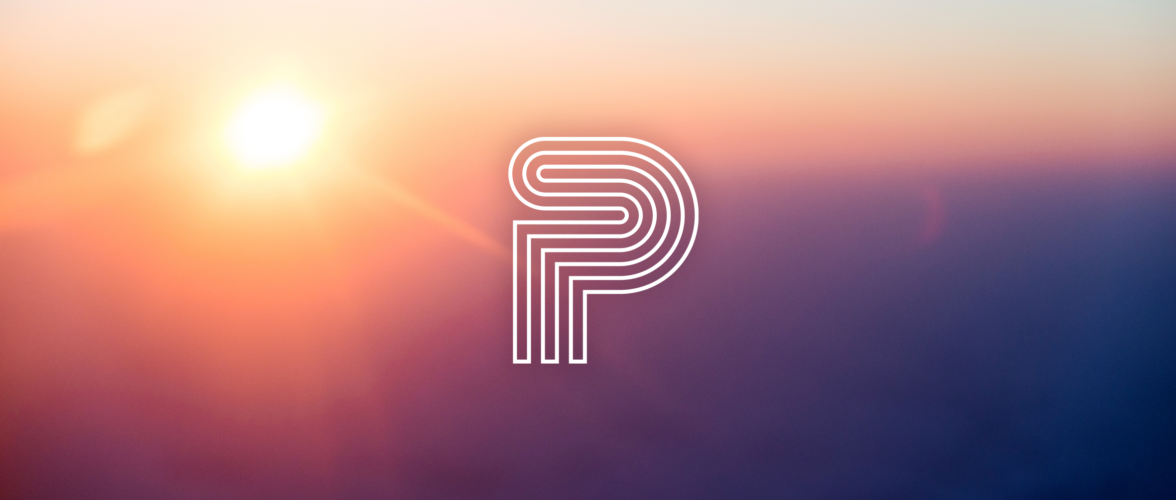
Posted on
August 25, 2022
2 Min. Read
Author
Purple Strategies
Purple Secures Growth Investment from WestView Capital Partners
Full Purple leadership team stays on as rapid growth continues, with new investment to continue developing offering that helps organizations anticipate, navigate and compel change.
Purple is pleased to announce it has welcomed the first strategic investment in the firm’s history, from WestView Capital Partners, a Boston-based private equity firm focused exclusively on middle market growth companies. Purple’s Co-Founders Steve McMahon and Alex Castellanos, Managing Partner Kristen Morgante, and all other Purple partners remain in their roles leading the firm as it continues to rapidly grow on the strength of its offering as strategic reputation partner to Fortune 500 companies and some of the most recognizable brands in the world.
“This investment is both recognition of the success Purple has built and enjoyed thus far as well as fuel for the next phase of our firm’s growth,” Purple CEO Steve McMahon said. “CEOs are feeling pressure from a new mix of stakeholders who expect companies to be their best selves, and it takes the unique blend of political, brand and reputation strategies Purple offers for companies to meet the moment. This is an external partner seeing the strength and relevance of Purple’s work helping organizations and executives address their toughest challenges. And it’s a power source allowing us to leverage their expertise in operationally scaling our firm for the next stage of our journey.”
“We are thrilled to partner with Steve, Kristen, Alex, and the rest of the Purple team,” said Jonathan Hunnicutt, General Partner at WestView. “We seek to invest in pioneering companies and Purple has demonstrated that it is in a category of one with its differentiated strategy, capabilities and approach in the market. The pace of change has never been faster, and it’s clear C-suite executives’ need for a trusted partner like Purple to navigate the issues they are facing has never been greater.”
“Purple is a place and team that some of the largest corporations in the world trust with their future,” Purple Chairman Alex Castellanos said. “This partnership with WestView is a signal to our team members and client partners that Purple remains strongly positioned for continued development of our offering and focused on creating opportunities for our people.”
“In deciding to bring on any investment partner, we knew it needed to feel additive for our clients and our Purple team members and allow us to continue to lead and manage the business in a way that preserves and stays true to what has made Purple special, and we found that partner in the WestView team,” Purple Managing Partner Kristen Morgante said. “They are interested in investing in Purple because they believe our offering is important and unique, they believe in our capacity to achieve even more success, and they believe in the team we’ve built. We’re incredibly excited to have them with us as we write this next chapter for Purple.”
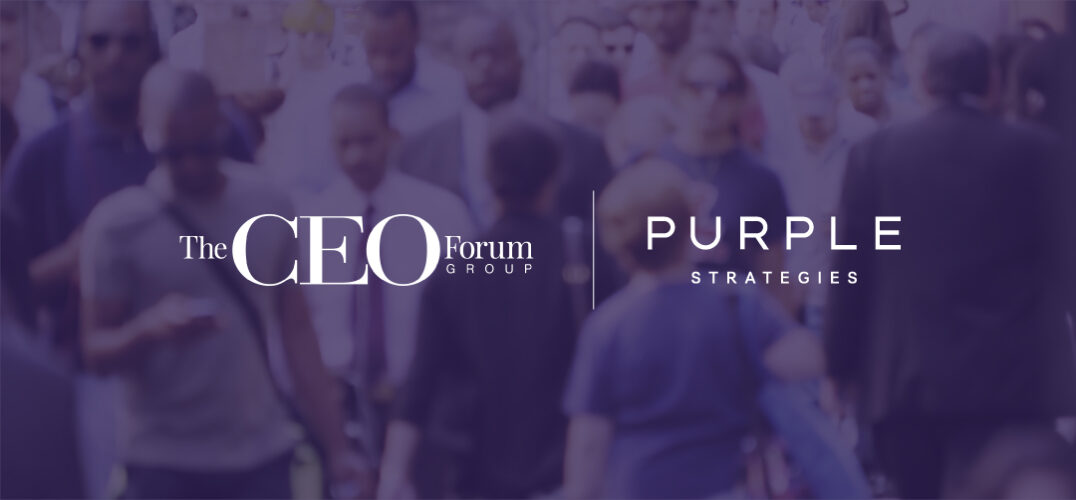
Posted on
June 16, 2022
4 Min. Read
Author
Purple Strategies
CEOs Embrace Expectation to go Beyond Corporate into Societal Leadership
Three Themes from The CEO Forum’s Second Annual Transformative CEO Summit
Purple Strategies is the thought leadership and polling partner of The CEO Forum Group and Transformative CEO Summit. The CEO Forum convened its Second Annual (and fifth quarterly) Transformative CEO Summit on April 21, 2022, featuring many CEOs of leading companies discussing creative ways to solve today’s most pressing challenges.
The story of the first-ever Transformative CEO Summit was about CEOs embracing the pivot from health crisis to human connection as the world emerged from the first year of the pandemic. The thread through discussions among executives at the second annual installment held in April of this year focused on a shift for the CEOs themselves as executives embraced growing expectations from stakeholders that they take on even more of the mantle of societal leadership.
The public expectation for business leaders to play a role in areas outside of their business interests is not new. But the pressure for business leaders to step into broader societal issues appears to be intensifying. Contending with the third year of COVID, along with an economy-shaking war in Europe, continued global supply chain disruptions, and more tipping-point moments at home around issues such as reproductive health, guns, justice and democracy, CEOs find themselves more often in the spotlight and more frequently called on to be a part of the solution to some of the most challenging issues facing society.
The following areas are at the forefront for CEOs as they lean into those growing societal expectations – what the Summit theme articulates as “creating a new world ecosystem” – and what might come next for CEOs.
(1) Leading society through workforce transformation.
Even in the space closest to “home” for executive presence – within the walls of companies – the need for CEO leadership is quickly becoming more expansive. To start, many of those walls are now virtual. Workforce realities have empowered employees to demand more flexibility and sustained hybrid work. How companies treated their workers, and in particular their working parents, became a variable shaping corporate reputation, as internal and external stakeholders watched and evaluated how well corporate America supported its employee base.
Those expectations around flexibility and supporting working parents are just two manifestations of a larger trend CEOs see of employees increasingly driving culture and pushing for clearer corporate purpose. Transformative CEOs aren’t threatened by the activism of their employee base; rather, they are measuring, understanding and harnessing their employees’ purpose and passion and using it to fuel both business success and the company’s ability to have a broader impact on society.

(2) Leading society through interconnected crisis and innovation.
In crisis playbooks of old, CEOs might have been guided through scenarios primarily impacting just the company, its customers, its industry, and the communities in which it operates. The last few years have seen crises become much more expansive, with CEOs being asked to lead in times of crisis through a complicated interconnected web of global health, race, economy and climate, all at once. Transformative CEOs agree that navigating this unprecedented style of crisis demands an unprecedented willingness on their part to flex and to fail. To flex, by throwing out old structures and silos and preconceived notions about what is possible. And to fail, by being open to big new ideas, failing fast and quickly course-correcting – a successful strategy through not only crisis but also innovation.
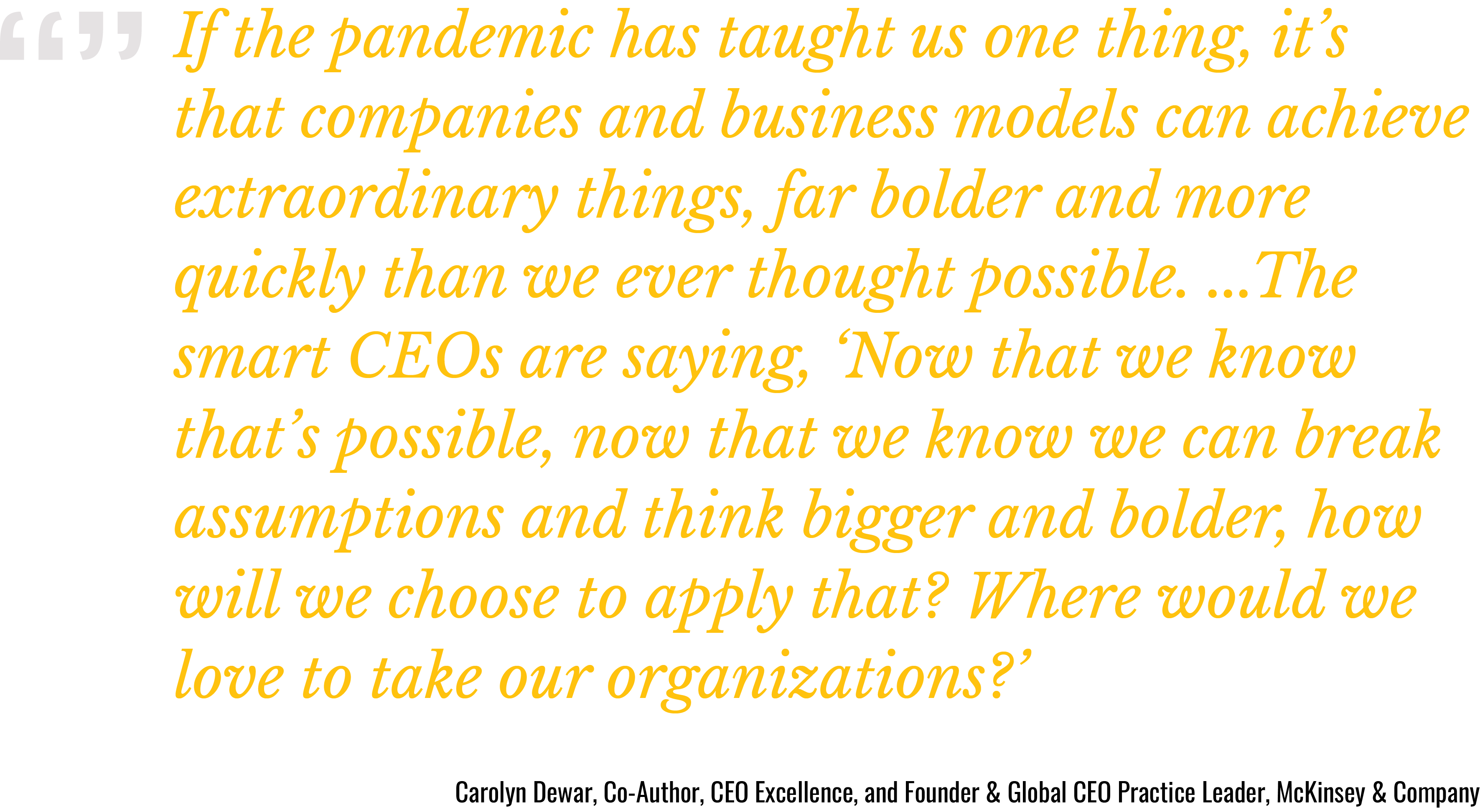
(3) Leading society through social and political issue discourse.
Americans increasingly expect companies to play a role in speaking out on issues impacting the public and society, while at the same time, more and more executives agree they have some responsibility to respond to major societal or geopolitical events. Purple Strategies polling of Transformative CEOs during the Summit revealed 3 in 4 feel prepared to weigh in or respond to societal issues on behalf of their companies. CEOs are also quick to point out that global impact doesn’t require action on a global scale: Authentic investment and commitment in a local community can build to influence the global community. As CEOs evaluate their purpose and responsibilities on these kinds of issues, Summit participants encouraged one another to be intentional about where, when and how they are using their voice – and then backing it up with actions.

While the growing remit of the CEO looks poised to continue into even more expansive societal leadership expectations, Transformative CEOs are ready for the challenge. Summit participants were united in optimism that CEOs are prepared to meet this moment of new opportunity and engage in shaping the global ecosystem that is evolving before our eyes.

Posted on
May 6, 2022
2 Min. Read
Author
Purple Strategies
Purple Adds Fourth of July Week Off
Since Purple was founded, the firm has closed down operations the last week of each year to celebrate the winter holidays and give its passionate Purple people a chance to unwind and unplug all at once. Now, Purple will be doing it twice.
Starting this summer, the Purple team will celebrate its independence each year with an entire week off for the Fourth of July (July 4-8 in 2022, and July 3-7 in 2023).
Purple Managing Partner Kristen Morgante, on the calendar addition (from LinkedIn):
“Our companywide wind down at the end of the year is something we treasure, so adding another such week – particularly after the weight and pace of the last two years – is something all of us welcome.
“Purple people have always loved spending time with Purple people and being available for each other and their teams. Sometimes, though, that causes them to feel that pull even when they are supposed to be out of the office if the rest of their team is in the office. It’s a tension all of us in a client service organization face if we’re passionate about what we do. And Purple people are that, in spades.
“So we’re working with our team to realize that their client and team focus not only allows for this kind of reset, it requires it.
“When our people are refreshed and recharged, we can see it in the work we do with our clients. The strategy, the solution, the research insight, the creative idea: They are stronger and better when the people behind them are at their best.“We can also feel it in the halls, over video screens, and in the Slack chatter that keeps us laughing.

Posted on
April 8, 2022
3 Min. Read
Author
Purple Strategies
Kristen Morgante Named Purple Strategies Managing Partner
Purple Strategies has elevated Kristen Morgante to be Purple’s first Managing Partner. Having been with the firm since its founding, Kristen has been COO for the past decade and was named a partner in 2015.
“Purple’s business and team have grown exponentially in recent years and increasingly all roads lead to Kristen,” said Steve McMahon, Purple co-founder and CEO. “Just as some of the world’s most significant corporations turn to Purple as a partner for navigating change, Alex and I turn to Kristen as our partner in charting the course for the firm. We are fortunate to have had her alongside us since the beginning and now in this new role for Purple.”
As COO, Kristen has been responsible for all day-to-day operations of the business and leading the firm’s long-term growth strategies. In her role, Kristen aligns Purple’s unique talent and expertise against client needs to deliver high-performing teams. Through her work with the founding partners, she is credited with scaling Purple’s client offering, building its dynamic culture, and creating a rewarding place to work for professionals from a cross a multitude of disciplines.
“Kristen is without question the heart and soul of Purple,” said Alex Castellanos, Purple co-founder and chairman. “This firm continues to be the special place that it is in largest part because of the sharp, talented people who make it their professional home. Kristen has been instrumental in shaping the experience of each person who walks through our doors, and I’m confident I speak for all of them when I say we’re excited Kristen has agreed to take on this role.”
Kristen got her start in Democratic politics, beginning her career in the Clinton Administration, and continuing her work on state and federal Democratic campaigns across the country, including Howard Dean’s Presidential campaign in 2004. Before Purple, Kristen served as Associate for Strategic Planning and Special Assistant to President and CEO John Podesta at the Center for American Progress. Kristen currently serves on the Board of Trustees for the nonprofit policy advocacy group, Stronger Fairer Forward.
“The team at Purple is extraordinarily special. I’m proud of our work in both partnering with clients to tackle their toughest challenges, while also investing in our internal culture and community to make this place a magnet for such brilliant and interesting people,” Kristen said. “The growth and success Purple has enjoyed has put us on an exciting path of transformation as a firm, and I’m grateful for the trust Steve, Alex and our other partners have placed in me to help ensure we continue to scale and evolve in ways that best support our outstanding team and our clients.”
In addition to Kristen and co-founders Steve McMahon and Alex Castellanos, Purple’s partnership includes Chief Creative Officer Jillayne Smyth Rogers, John Gatti, Chris Durlak and Rory Cooper; and founding partners, emeritus, Mark Squier and Robin Roberts.

Posted on
March 23, 2022
4 Min. Read
Author
Keeley Hanlon
Five Pandemic Trends Leaders Should Leave Behind—and One That’s Here to Stay
A VERSION OF THIS ARTICLE FIRST APPEARED IN FAST COMPANY
Over the past year, preeminent CEOs from across the country convened for a series of Transformative CEO Summits, hosted by The CEO Forum Group and supported by Purple Strategies. As the year ended, we reviewed what those CEOs had to say on a range of topics and what year three of the pandemic brings for their companies, workforces and the global economy.
While these discussions uncovered lessons to carry into this third year of pandemic-era leadership, top CEOs also identified trends from the past year worth leaving behind.
LEAVE THESE
Using terms such as “post-pandemic” and “back to normal”
Across industries, business operations have been mired by unpredictability since the COVID-19 pandemic began. More than once, however, it seemed we neared the beginning of the end.
Now with variants raging and record-high COVID-19 cases continuing to make headlines, today’s leaders understand a return to pre-pandemic business is unlikely anytime soon or ever, and many of the challenges wrought by COVID-19 are here to stay.
CEOs have learned to expect the unexpected. They make plans for the months ahead while encouraging their organizations to prepare for every potential scenario.
Establishing a “return to work” timeline
As of March 2022, many corporate employees have spent the past two years working from someplace outside the office, and for most, that set-up won’t change anytime soon.
Top CEOs acknowledge that corralling folks back into the office five days a week might be near impossible. As a result, they are prioritizing flexible solutions that meet the unique needs of their organizations and employees. The majority (66%) of CEO Forum Group leaders we surveyed in July 2021 indicated their companies plan to operate in a hybrid model going forward, acknowledging employees’ desire for continued workplace flexibility.
While remote work has introduced the dreaded “Zoom fatigue” to many people, company leaders and their employees alike have recognized that virtual meetings have their benefits too. Nearly two-thirds of workers reported having more access to their leaders now than before the pandemic, according to Purple Strategies’ polling of the employed Informed Public. As one CEO put it, “There is no hierarchy in a Zoom call. No head of the table. There’s something really empowering about that—it leads to a more innovative culture.”
Believing a public statement on an issue is enough
Leaders and companies have demonstrated their willingness to address some of the country’s most pressing issues head-on. But more and more, they’ve realized that speaking out isn’t enough. Successful companies will differentiate themselves by making substantive commitments and providing transparent updates on their progress.
When it comes to making substantial progress against their DEI and ESG commitments, CEOs agree on the importance of setting concrete and attainable goals around issues like creating an inclusive workforce and advancing climate sustainability. Taking this step forces their companies to follow through on the plans they’ve announced. Driving transformative change goes beyond chasing positive PR—these values and aspirations must be embedded into a company’s DNA.
One CEO shared, “We expose our diversity and inclusion metrics to the world in a public forum; there was collective recognition and actions like that really do help drive change.”
Assuming there’s a choice between automation and technology or people and jobs
The pandemic has only accelerated the adoption of cutting-edge technologies, but conversations around what this transformation means for workers have centered around a false dichotomy between job creation and job losses.
CEOs successfully implementing next-generation solutions know that while automation and technology are critical to advancing the efficiency and convenience that pandemic-era customers have come to expect, people remain essential when it comes to applying creativity, making ethical decisions and operating with humanity. During the Second Transformative CEO Summit, one CEO said, “We need to humanize digital implementation.”
Leaders see a window of opportunity to up-skill their workforces to work with the latest technologies. Last year, 45% of CEOs reported reskilling their employees as a primary focus area when polled during the Second Transformative CEO Summit. By seamlessly implementing automation and new ways of working while preparing workers for higher-paying jobs essential for future success, leaders can create a win-win situation for everyone.
Treating the Great Resignation like a waning, pandemic-driven phenomenon
More than 4.5 million Americans quit their jobs in November 2021, the highest rate in more than two decades. The pandemic made employees feel emboldened to realign their priorities—to focus on family, find more purpose-driven opportunities or pursue a new career path entirely—and employers must be willing to do the same. That means examining pay structures, benefits, set hours and expectations for commuting and in-office work.
Leaders are also seeking to ensure purpose and fulfillment are part of the deal. If the great resignation has taught us anything, it’s that many Americans look for opportunities that provide more than a paycheck.
“The old playbook is gone,” said a CEO in the financial industry. “Leadership requires purpose-driven, future-forward and leader-led transformation.”
KEEP THIS
Maintaining human connection in the workplace remains crucial to success
The one trend of “year two” executives should continue to implement in the third year of the pandemic? Empathetic leadership.
For 44% of the Informed Public, being in a workplace with empathy and human connection is more important now than before the pandemic (with another 40% indicating it has always been important). This new emphasis on empathy is even higher for employees who are 18-34 years old (52% say it is more important now), parents (49%), working in a fully remote or hybrid environment (49% each), or whose volume of work (48%) or level of work-related stress (53%) has gone up during the pandemic.
Empathy is no longer an abstract, new-age idea in executive management; Fortune 500 companies are learning it’s mandatory in their C-Suites.
Why is that? Empathy can be the antidote to each of the challenges outlined above. Recent research from Catalyst found that empathetic leadership can boost productivity, foster creativity, promote feelings of inclusion and reduce intent to seek new employment.
The good news is many leaders agree with the Informed Public. “There is an opportunity to use empathy to think about new ways to connect with people,” one CEO from the banking industry said. “Empathy should make a strong comeback and is the key to building trust. And that’s where the growth is.”
The ability of leaders to practice empathy will be critical not only for the year ahead but for the evolving future of work as we know it.
Throughout 2022, businesses will need to identify and react to a new set of emerging trends and evolving COVID-era mandatories. Leaders from Capitol Hill to Wall Street to Main Street frequently look to corporate America for guidance, so companies can set the tone by leaving recent pandemic-driven trends behind and leading with empathy, creativity and flexibility.
By Keeley Hanlon | Senior Director

Posted on
February 9, 2022
5 Min. Read
Author
Purple Strategies
Teammate Reflections on Black History Month
In honor of Black History Month, Purple’s Diversity, Equity and Inclusion leads invited some of the incredible Black talent across Purple to share reflections about what this month means to them, Black leaders who inspire them, and more. Below, we highlight their perspectives on Black history, culture, traditions, joy and excellence.
With contributions from: Sedale McCall, director of digital insights and one of Purple’s DEI leads; Jasmine Graves, research analyst; Antoine Fagan, designer; Georgia Boothe, accountant; Giselle Tervalon, communications manager; and campaign coordinators Latisha Townsend, Kimberly Chavis, Jaymi Thomas and Chioma Onwumelu.
What Black History Month means to you.
- Georgia: Black History Month is a celebration of our ancestors’ excellence and motivation to always strive for the greatness that lies beyond our current circumstances. It is an important time to celebrate the impact of African American culture in the past and present. It reminds us of hope and opportunity for the future.
- Giselle:
- Jasmine: Black History Month gives us the opportunity to reflect and gain an understanding of the Black experience in America. Black History Month can foster a sense of community both within and outside of the Black community through learning about Black history that is often missed.
- Jaymi: Black History Month is always a time for me to focus on aspects of history that are fascinating, inspiring and packed with nuanced experiences. One of the most enriching moments I had as a college student was crossing the Edmund Pettus Bridge from Selma to Montgomery, Alabama while I was taking a sociology course.t was a reminder to me that in the summer of 2007 when I crossed the bridge, leaders and laypeople alike crossed that bridge less than 50 years prior. Black History Month reminds me to pause, reflect and honor the legacy of those that led and paved the way for freedoms that shouldn’t be taken for granted.
- Kimberly: To me, Black History Month is the time to celebrate and showcase all things Black. To really soak in and appreciate all our achievements, cultures, traditions and customs. It’s also a great time for allies to further educate themselves on just how valuable Black people are and have been throughout American history, past the obvious.
- Latisha: Every month is Black History Month for me! During the month of February, I think it’s a great time to be in communion with Black people all across the African diaspora. There is a certain knowing we all share, and that feeling is unmatched. To me, BHM means accountability, reflection and unity.
- Sedale: Black History Month provides a moment for others to learn about the community and highlight the progress of African Americans in the country. I think that’s something I try to do every month, but I appreciate the moment for others to focus more.
Black History Month traditions.
- Antoine: During Black History Month, I support Black businesses of all kinds: clothing, food, hygiene, self-care and art. There are so many Black business owners, especially small businesses, and entrepreneurs with a great product or service. They deserve both emotional and financial support.
- Chioma: I watch some Black classics and pick a novel from the Well-Read Black Girl Library!
- Giselle:
- Kimberly: I buy from and support Black businesses year-round, but during BHM I really turn it up a notch and try to make sure anything I spend my money on is coming from a Black business. I also like to watch my favorite Black movies and TV shows all month and cook all my favorite childhood foods.
- Latisha: I enjoy watching Black films, reading Black literature and listening to Black podcasts and music. I do this regularly, but I really like the way that our talent gets amplified during BHM.
A Black leader who inspires you.
- Chioma: I’m inspired by Kimberle Crenshaw, civil rights advocate and critical race theory scholar, and President of MSNBC Rashida Jones.
- Georgia: Michelle Obama because she is truly a modern-day, revolutionary woman who has championed a multitude of important causes throughout her life. She is a Harvard graduate, lawyer, best-selling author and the first African American first lady. Michelle Obama is proof our country has indeed evolved.
- Jasmine: Madam CJ Walker has inspired me as a young Black woman really interested in hair care since the age of seven. Many people know her and admire her because she was the first Black millionaire. However, I think her civil rights work, dedication to improving the lives of African Americans through jobs and opportunities, and impacts on the hair care industry are significantly more admirable. She once said, “I am not satisfied in making money for myself. I endeavor to provide employment to hundreds of women of my race.”
- Jaymi: I am inspired by countless Black leaders who have blazed paths and continue to move the needle forward in modern-day civil rights and justice. A couple of the “under 18” leaders captivating me include Naomi Wadler, who at age 11 shifted the atmosphere during a March For Our Lives speech, and Marley Dias, the purpose-driven 16-year-old who founded #1000BlackGirlBooks and author of the book, “Marley Gets It Done.” I am amazed by how these young women shine and share their gifts with the world in brave and innovative ways.
- Kimberly: bell hooks. Her writing has been majorly influential in the empowerment of Black women to tackle love, race and gender inequalities, and more. I think her work is reviving a movement in Black women today.
- Latisha: A Black woman leader who inspires me is Judy A Smith, a crisis management expert. A Black male leader who inspires me is Malcolm X.
- Sedale: I have two for similar reasons, Dr. Ibram X. Kendi and Ta-Nehisi Coates. Both give context to the things many of us believe but don’t always express through words. Many people know Dr. Kendi as the author of “How to Be an Anti-Racist,” but he is also director of the Center for Antiracist Research, which he started at American University (now at Boston). Both are advocates for many things, but chief among them is knowing better so that we can do better. This is my passion in this space as well.
Other reflections to share.
- Antoine: Black is beautiful, creative, fun, loving, persistent and brave. Be proud of your Blackness at all times.
- Jaymi: As someone who is inspired by history and reflective in nature, I am passionate about the work of future Black leaders – those who will be able to say they lived and created hope and light during some of the bleakest moments including a pandemic, heightened loneliness, civil unrest and turbulent political polarization. In a landscape where some states are wrestling with what it means to teach Black history, my hope is that Black History Month serves as a sort of north star in the conversation around the importance of teaching history with breadth and depth.
- Latisha: Cultural competency in the workplace is of high importance. During Black History Month, non-Black colleagues can show support by listening, respectfully engaging in conversation about Black history, and treating BHM and all other Black holidays as commemorations solely of Black people.
- Sedale: I believe Black history is American history. If you are wondering how to celebrate or observe, whether you identify as Black or not, learn about a Black leader you haven’t studied yet, or even learn more about a Black colleague and their experience. When we learn more about other communities, we can be better as a society.
 Reclaiming Trust When Under Fire
Reclaiming Trust When Under Fire  Reclaiming Trust When Your Products – and Intentions &...
Reclaiming Trust When Your Products – and Intentions &...  Brad Dayspring Joins Purple Strategies as Executive Director
Brad Dayspring Joins Purple Strategies as Executive Director  Celebrating Growth and Leadership at Purple
Celebrating Growth and Leadership at Purple